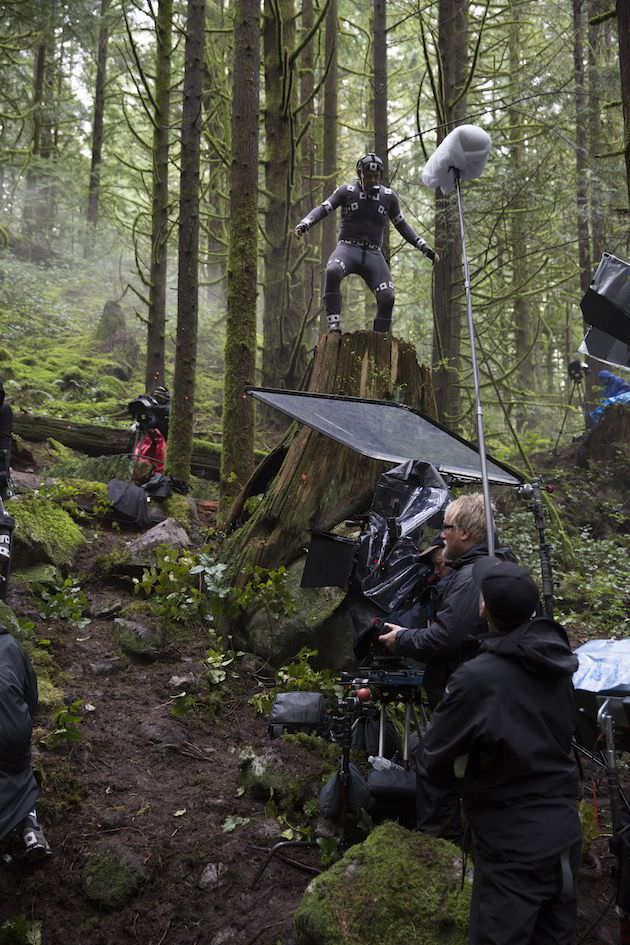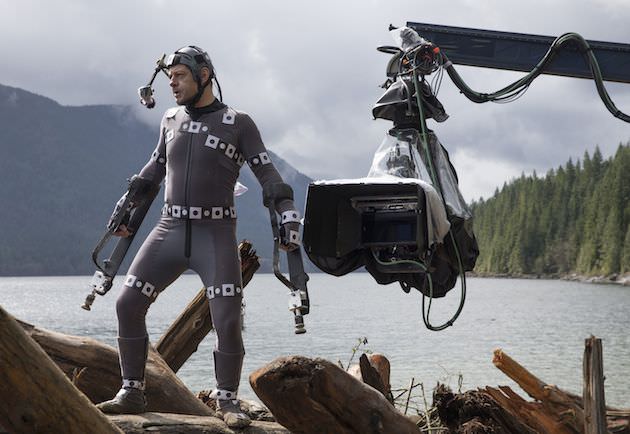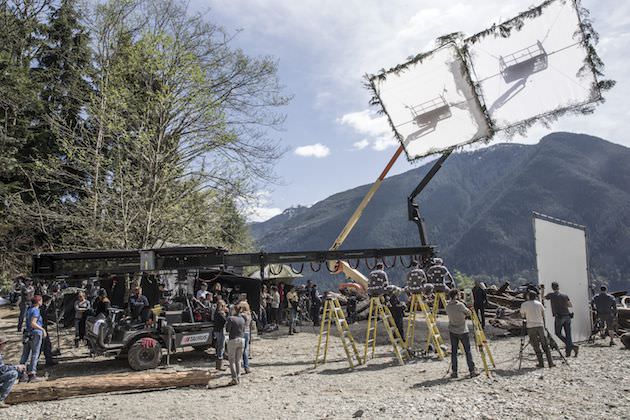Dawn of the Planets of the Apes Location Manager on Filming in Rainforests
It has been ten years since the last human and ape contact. That last contact was combat, and it took place on the Golden Gate Bridge in a frenzied battle between a recently intellectually enhanced ape faction, led by the chimpanzee Caesar, and the bewildered humans who were not prepared for the coordinated assault of their suddenly intelligent, formerly captive simian subjects. The film ends with Caesar and his primate army heading into Muir Woods, north of San Francisco, where they’ll build a new society and live peaceably for a decade, until Dawn of the Planet of the Apes begins. While Caesar and the apes have been building their new world in the forest, humanity has been ravaged by the simian flu that was unleashed at the end of Rise.
Dawn of the Planet of the Apes concerns itself with the arrival of a band of surviving humans in Caesar’s forest. Led by Malcolm (Jason Clarke), the humans are desperate, attempting to access a dam, deep in the forest, to help their fellow survivors. The human living situation is beyond bleak— cities have been ravaged, and survivors are left scavenging for food and living in a state of constant paranoia after a decade of mass death and violence.
The job of finding, securing, and managing Caesar’s new home fell to location manager Catou Kearney. It is essential to the storyline of Dawn that the apes live in a forested sanctuary that has become lushly overgrown in the ten years humans have been largely wiped out and, therefore, unable to infringe upon the natural world. The apes live in peace, hunting together, caring for their young, and combining their animal instincts with their genetically enhanced intelligence. They are becoming more adept at language, have mastered fire (which they contain and hang in lantern-like creations they use in their shelters), learned to share their memories, and have created a vast forest utopia. Finding such a place, one that looks as abundant as the script demands, but that could also support a large crew and a ton of equipment, takes months of research, legwork, and a few thousand phone calls. Kearney is a seasoned location manager, and relishes the opportunity. "It's like putting a ten-thousand piece puzzle together," she says. "When that last piece falls into place, there's nothing like it."
Mimicking Muir Woods

Dawn was not, however, shot where it's set, in Muir Woods or San Francisco. The shoot was broken up into the San Francisco-set scenes, which were shot in New Orleans, and the Muir Woods scenes, which were filmed in the rainforests in and around Vancouver. Kearney's role as location manager makes her responsible not only for finding the forests but also managing those locations, from pre to post production, talking and guiding all the players through the process, and leading whatever restoration and replanting work might need to be done.
Long before cast and crew were out there amongst the trees, Kearney and her scouts were reading the script and using their deep knowledge of the Vancouver area to begin thinking of appropriate locations. “It’s based on what I know and what I don’t know about the areas I can access; do they allow filming, and if so, is this a place where I can support a unit for the installations we’re going to want?” Another added difficulty in planning for Dawn was the sameness of forest photographs. “Because it’s all forests, it becomes difficult…a tree is a tree is a tree, so you have to find something unique in each location so people can attach to that and identify it,” she says. “You want to give the director or production designer the ability to say, ‘What about that forest that had that beautiful green moss and that river?’” Once Kearney has winnowed down the photos to a digestible number, she posts them so everyone, from Los Angeles to New Orleans, can make their choices.
Another requirement of the Dawn shoot was finding a section of forest that looked utterly remoted and virgin but was, in actuality, accessible to cast and crew. “Part of our job was finding really forested areas that don’t look at all populated—you don’t want to imagine someone walking their dog through it every five minutes—but I still have a unit to support,” Kearney says. “I need to find forested areas that still have trails, because you have to get your trucks in, your crew, your gear, so you’re finding pockets within the forest that are reachable and attainable.”
Eventually Kearney and her crew found suitably stunning rainforests to mimic the massive redwoods of Muir Woods along the north shore of Vancouver and just outside of Vancouver in Maple Ridge. Instead of those Northern California redwoods, Caesar and the rest of his primate cohort in the film are actually living amongst mostly second growth cedar and pine trees native to the Vancouver region, large and lush enough to fulfill director Matt Reeves, production designer James Chinlund and art director Naaman Marshall’s needs.
Once the locations have been chosen, Kearney’s job actually becomes much more intense. “I oversee all of the site preparation beforehand and restoration after, as well managing the locations as filming in the various areas begins. I’m responsible for all the municipal permits, the provincial permits, and I assist hiring police officers or paramedics if we need them.” Kearney’s assistant was on set throughout filming, trying to “bridge the gap between the needs of the shooting crew and the realities of the location we’re in,” while Kearney herself tries to be five steps ahead of production, making sure all the other locations are moving ahead as they should. "And then once we're done filming, I go back in to make sure we’re restoring that location and keeping everybody happy as we go.”
The Most Ambitious Performance Capture Film of All Time?

Kearney, who is a veteran location scout and manager with 15-years of experience, said that the entire Dawn filmmaking team had extremely ambitious goals for what this film could be, one of which included marrying live action and motion capture, as Rise’s filmmakers did so brilliantly in 2011, with the added element of 3D. This means that the size and scope of the equipment was going to be much larger on this film. “There is no WiFi in the rainforests,” she says, and adding to the complexity is that many of the locations she eventually found were in North Vancouver, a hilly forested region. “Just physically getting from point A to point B was very hard. The crew was logging a lot of kilometers, and it’s not like they could bring in golf carts to haul the gear, so they had to carry it.” If you’ve never schlepped film equipment—cables, monitors, cameras, apple boxes, all manner of lighting equipment and a few hundred other pieces of necessary gear—it’s hard to imagine just how difficult hauling this stuff is a few hundred feet, let alone in and out of a hilly rainforest.
Filming got harder, thanks to an unusually long lasting winter. “We specifically scouted our locations to be beneath the snow line, but the snow lingered and it was very, very cold,” Kearney says. Then, as filming coincided with the start of spring in April of 2013, the rain hit. Hard. “It was very, very wet, that first week of principal photography was tough. You’ve got a new crew trying to gel, and you’re in the middle of the woods and it’s constantly raining."

Andy Serkis told IGN’s Scott Collura that there was practically no set work during the shoot, and that not only were they constantly filming outside, they were also attempting to create the most ambitious performance-capture film to date, more so than Avatar, Lord of the Rings or The Hobbit. “In Vancouver, we had the weather to deal with; it was freezing cold and raining every single day. We're putting cameras up in trees, covering large areas,” he said.
Protecting Your Set
When it comes to protecting the locations they used, Kearney said that the production had a fantastic Greens Department, a technical union that falls under the jurisdiction of the art department and construction crew. “You have so many meetings before a film crew even sets foot in the area as to what you’re going to do to protect the environment, make sure things aren't damaged, and, if you need to replant, what that’s going to be like.”

Protecting the environment also required some creative thinking and brilliant engineering by the filmmakers. They built 20×20 platforms in the forest that held equipment and crew, lessening their literal footprint on the forest floor. The Greens Department helped hide whatever technology couldn’t be housed on the platforms, as well as the trails the cast and crew used to access the location, by spreading black fabric, pine needles and leaves to cover everything and create the illusion of an overgrown forest that has flourished from a lack of human encroachment.
“When people see the movie, I don’t know that anybody ever realizes just how difficult these situations can be for the crew to work in, and how hard they work to make these movies as good as they can," Kearney says. "Physically, this was such a difficult film to make, and the crew did such an amazing job, and they were so great and respectful of the environment. You have to know the movie's going to be good when the people who worked on Dawn, on all these long, hard days, see the trailer and they’re excited for the film. When the jaded people are excited, you know it’s good."
Featured image: Jason Clarke and Andy Serkis (in performance capture shoot) film a scene in Dawn of the Planet of the Apes. Photo credit: David James. Courtesy 20th Century Fox.



